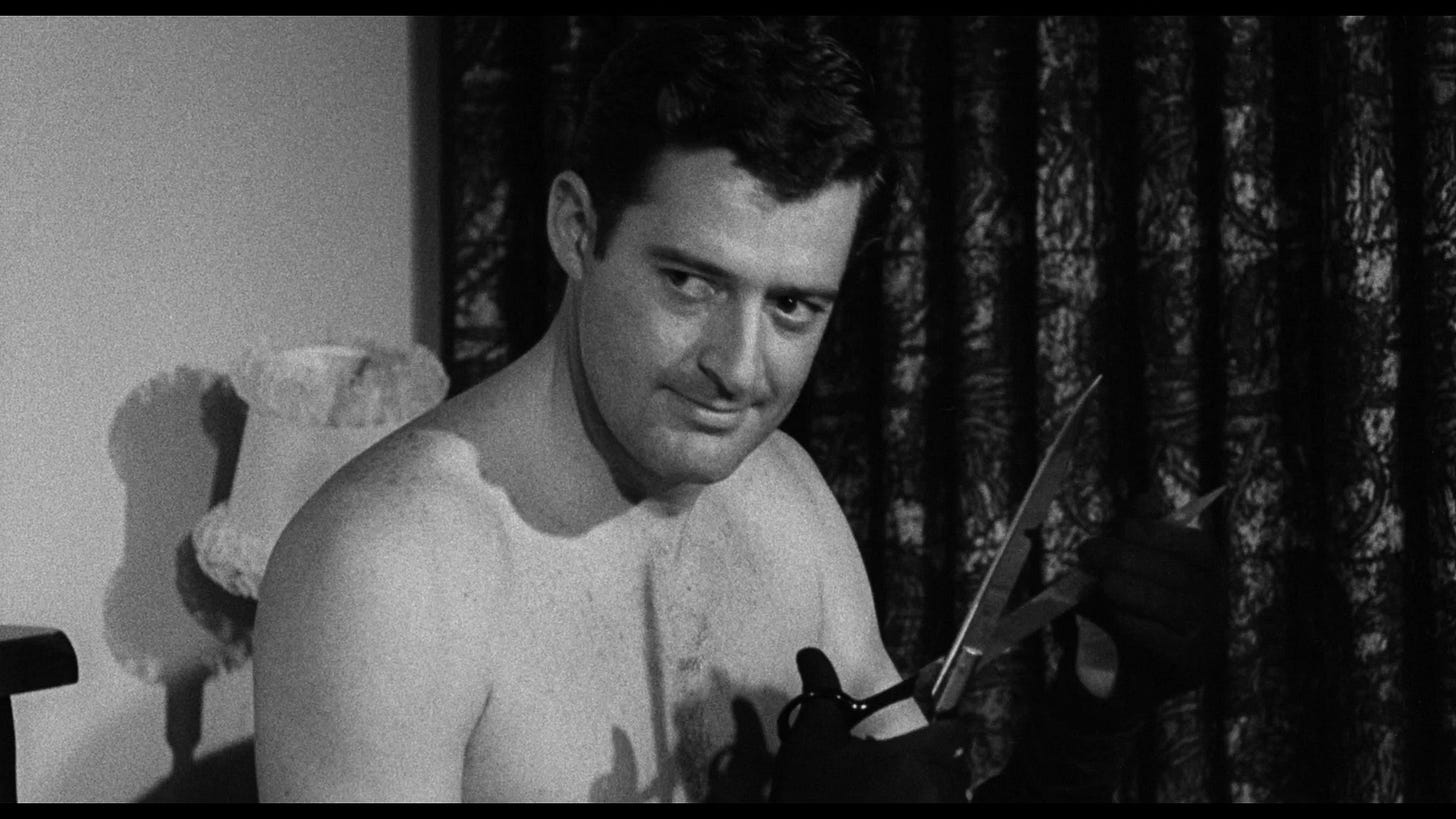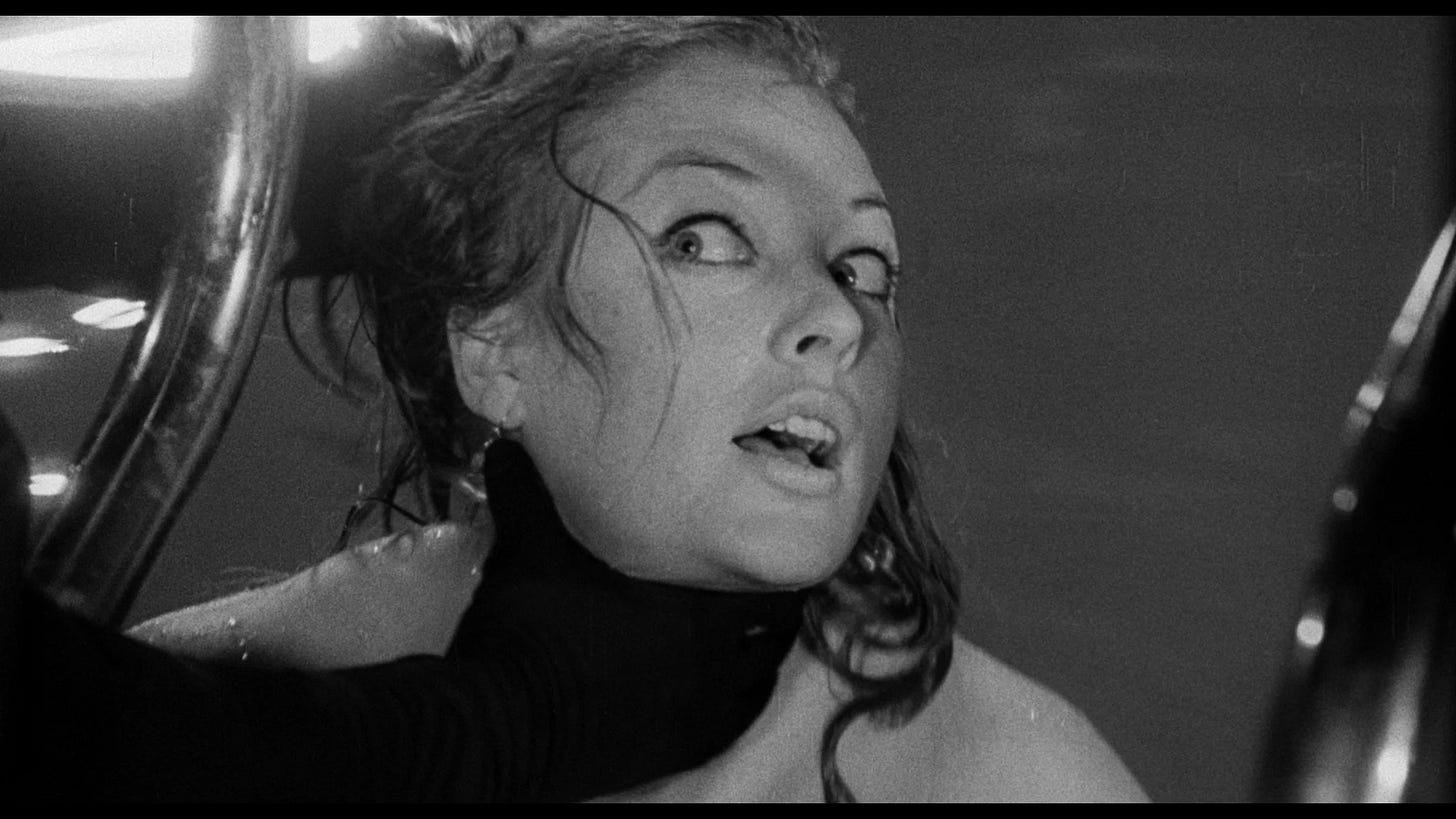This is the second in a (hopefully) ten-part series on film preservation. Using Vinegar Syndrome’s Lost Picture Show box set as a guide, each post will focus on a different genre and the importance of preserving film history, regardless of how “good” or “bad” we think the films might be. The first on Barbara can be read here.
The 1960s was a transitional time for America. As the decade progressed, societal opinions about civil rights, Vietnam, sexuality, homosexuality, authority, drugs, religion, and a whole spectrum of other beliefs and systems were questioned. Nothing was free from scrutiny. Morals were loosened. Protests were made. In the midst of all this, in a desert oasis, another lost film was made: The Las Vegas Strangler (1968 - also titled No Tears for the Damned). It is a film that captures another glimpse into a time in history; however, this time it also captures a place in history.
Although The Las Vegas Strangler was filmed in 1964, it did not receive a theatrical release until 1968. It is hard to watch it and not see inspiration from Psycho, another early slasher that was released in 1960. I would be interested to gauge audiences’ reaction to the film and its similarities to Psycho, although I doubt people in the 1960s cared as much as we do today about whether or not a film “rips off” its plot from other films. Watching the film, it is fascinating to see the cultural changes that occurred in the four years between the release of Psycho and The Las Vegas Strangler. The film looks and feels like a mid-60s film more than a late-60s film.
Much of the film is lost among shots of Las Vegas as it was in 1964 and showcasing the victims in various states of undress during the murders. Seeing a semi-stripped-down version of the Las Vegas we know today adds to the film's charm. Only a handful of scenes actually show exterior locations for Las Vegas, but without them, this would be just another generic film set in anywhere, USA. Just because this is Las Vegas 60 years ago, does not mean it is not without its usual sin and iniquity. Lori (Gillian Simpson) is a barmaid who is forced to prostitute herself at her stepmother’s bar. However, this is still the early 1960s, and she presents herself as a much more cleaned-up “good girl” type. It is only after her marriage to Jeff (Robert Dix) that she begins to show off a little bit. There is still something sleazy and gross about Lori’s entire arrangement. Probably the stepmother of it all. But it is handled in a way that feels more in line with a 1950s morality than it does the 1970s cynicism. Even the Las Vegas showgirl act that Jeff takes Lori to feels more modest than the Las Vegas we have grown accustomed to.
The film's real appeal, for me, is looking at its place within the historical spectrum of slasher films. I think we love to look at films like Psycho, Black Christmas (1974), Halloween (1978), etc., and connect a line between each one as if they built off each other in a vacuum without any consideration for the numerous other films that helped build the genre. 1960s Peeping Tom is another early slasher that seems to be both praised and overlooked due to its release at the same time as Psycho. It also did not help that audiences found Peeping Tom to be controversial at the time due to its violence and sexual content. In Italy, the Giallo genre kicked off with Mario Bava’s films The Girl Who Knew Too Much (1963) and Blood and Black Lace (1964). A genre that may or may not have inspired Bob Clark’s Black Christmas. Who knows if anyone working on these films in the 1970s was inspired by The Last Vegas Strangler? Either way, it would be wrong for us to ignore its place as an early slasher.
These films released in the 1960s allowed more blood and nudity than audiences had grown accustomed to at the time (virtually, none), but they put a heavy emphasis on the psychological mindset behind the killer. It wouldn’t be until 1974 with Black Christmas and The Texas Chain Saw Massacre (1974) that we would start to see killing for killing sake. Fitting for the most misanthropic and depressing decade in American history to date. Both Peeping Tom and Psycho give their antagonists psychological trauma to motivate their compulsive killing habits. Norman Bates in Psycho had a mother who was so overbearing and mentally abusive that she continued to live rent-free in his head, which conflicted with his desires and autonomy. Mark Lewis in Peeping Tom was the victim of his father's psychological experiments on fear. In Italy, the Giallo killers almost always had trauma either via a complicated relationship with sex or by witnessing a murder (usually as a young child) which had negative effects on them as they got older.
The Las Vegas Strangler never gives the audience the satisfaction of knowing why Jeff kills. We know that Jeff feels his mother is too controlling. But what does that have to do with the way she dressed him as a child and the creepy painting of him? Why does he marry Lori (Gillian Simpson) instead of killing her? It is implied he has already killed before, so what use is a wife to him now in his chase for normalcy? Unfortunately, as Jeff, and the film, reach its climax, it abruptly ends. It is almost like there is an entire reel of film missing. We never really learn the extent of Jeff’s mother’s abuse. There is no resolution. There is barely a climax. This is a shame because everything up until this point has been mostly implication and build-up. There is a subplot in which Jeff struggles with his feelings towards another man which is never fully addressed or resolved. There are numerous questions we can ask ourselves about the plot of this film with little to no satisfying answers.
Films like The Las Vegas Strangler exist on the fringes of Hollywood. I feel like a broken record claiming that lower-budget films made by outsiders often have their finger on the pulse of society, or a subsection of society, better than Hollywood and the rest of the mainstream, but films like this only confirm that fact. Director William Collins and writers June & Oliver Drake are not the only creatives to make films in Las Vegas, or early slasher films, but only they can create a film in Las Vegas at a specific time in history using their own personal influences and experiences. Maybe they were trying to remake Psycho in Nevada. Maybe they were a couple of perverts at the right time and place in history. The unfortunate thing about these films being “lost” is that there is very little information to go off of in terms of research. Without a direct link to the source, we can only speculate. Apart from that, we can sit back and enjoy what they created, try to appreciate it for what it is not for what it is not, and take a glimpse into another time and place.





